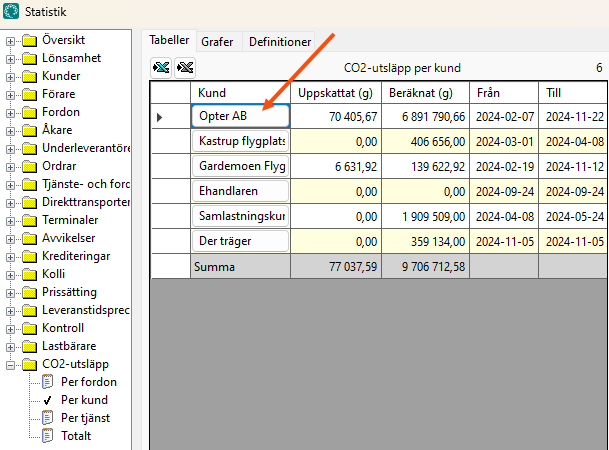Last updated: 2025-03-28
Creating a statistical report about CO2 emissions in grams
In this Price item
To gather details regarding the climate impact calculated for your transport in terms of carbon dioxide emissions, the CO2 emissions statistical report can be used.
The exact climate impact of an individual transport operation depends on the actual consumption and specific fuel, what other goods were being transported at the same time, how much of the transport operation the vehicle had to be driven when empty, etc. It is difficult to obtain precise values for this data, so standard values are used for the fuel consumption and the CO2 emission factor. The standard values are selected so that the climate impact data is reliable on average over time.
The statistical report is based on templates. To get it as accurate as possible, you need to find out your actual CO2 emissions, for example by totalling everything refuelled over a period of time. Then try out different factors on services until the sum in the statistics matches the reality and the allocation between different shipments is reasonable.
A statistical report can be created that shows the amount of CO2 emissions calculated to have been generated by the transport operations over a given period. Reports can be created per:
-
vehicle
-
customer
-
service
-
total for the office.
It is then possible to click on a vehicle, customer, service or your company name (office name) in the statistics report to see the calculated CO2 emissions per shipment.
The statistical report displays the following two columns for CO2 emissions:
-
Estimated (g) is an initial calculation of the order's CO2 emissions. The calculation is based on the information that is available at the time the customer places the order.
-
Calculated (g) is the calculated CO2 emissions for a shipment. The calculated CO2 emissions for a shipment is a more accurate calculation than the estimated CO2 emissions for an order, as this calculation is also based on information about the actual vehicle and distance relating to the shipment.
For more information, see CO2 emissions in grams, overview and How Opter calculates CO2 emissions.
Conditions
For Opter to calculate CO2 emissions, the following applies:
-
You must first make the settings described in Settings for CO2 emission calculations.
-
There must be a distance on the order. For more information on how to get distance on orders, see Distances, addresses and maps, overview.
Create a report about CO2 emissions
-
Click on Analysis > Statistics. Open CO2 emissions by clicking on
 .
. -
Choose which statistics to display by clicking on Per vehicle, By customer, By service, or By office. If you click on By office, the aggregated statistics for the office are shown.
-
Select Period at the top right of the window.
The date period is based on the order date on the order to which the shipments belong. Sometimes shipments are transported the day after the order date, but the order date is the most useful date for comparing with other statistics.
-
Click on Ok to create the statistical report.
For example, if you selected By customer, the estimated and calculated CO2 emissions for each customer for the period you selected are shown.
-
To display more details, click on one of the customers in the table.

If you selected Per vehicle, you can click on one of the vehicles in the table to see more details. Similarly, it is possible to see more details if you chose By service or By office.
The table that is shown is wider than the window, but you can scroll right to see all the information.
The statistical report also includes the underlying data on which it is based. To work more with the data, it can be exported to Excel by clicking ![]() or
or ![]() .
.